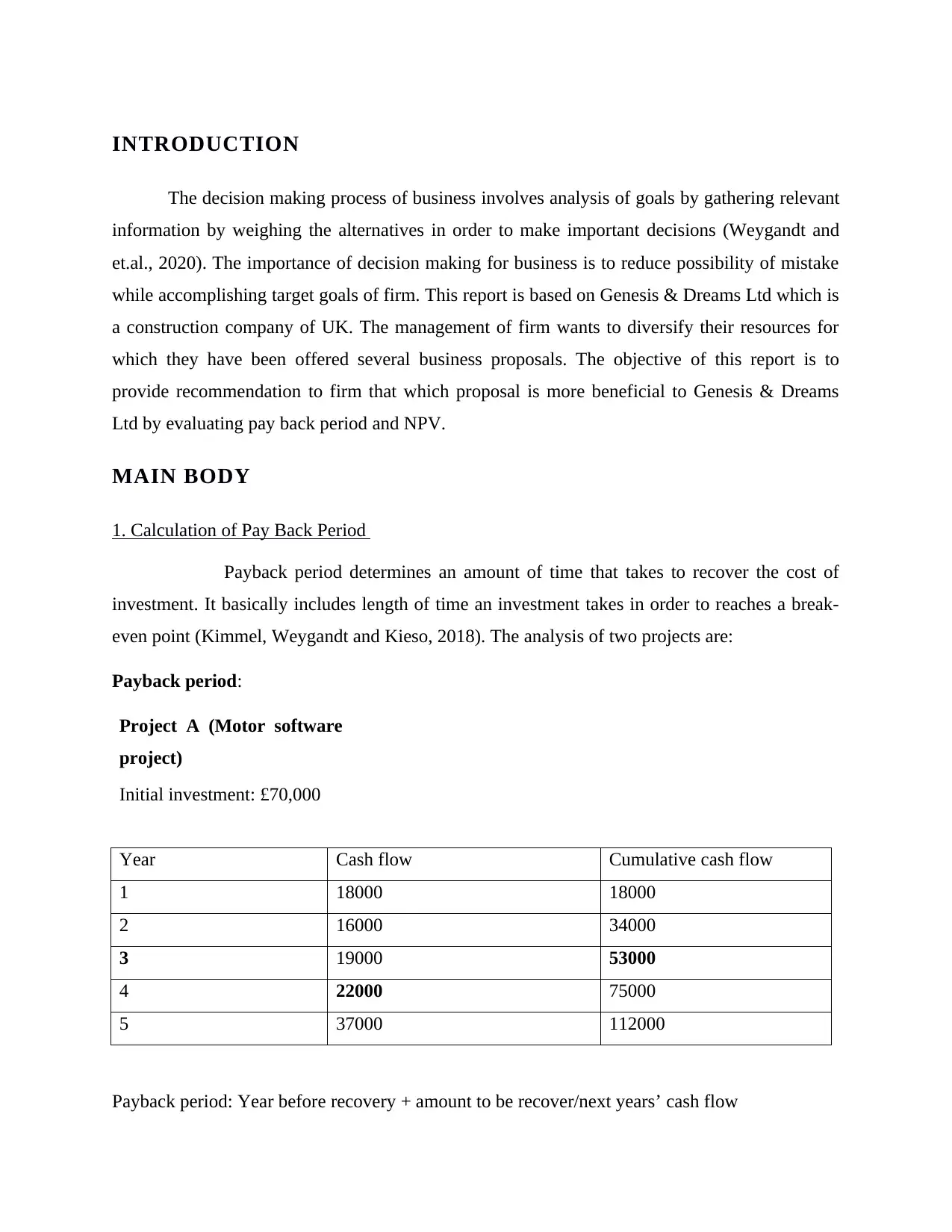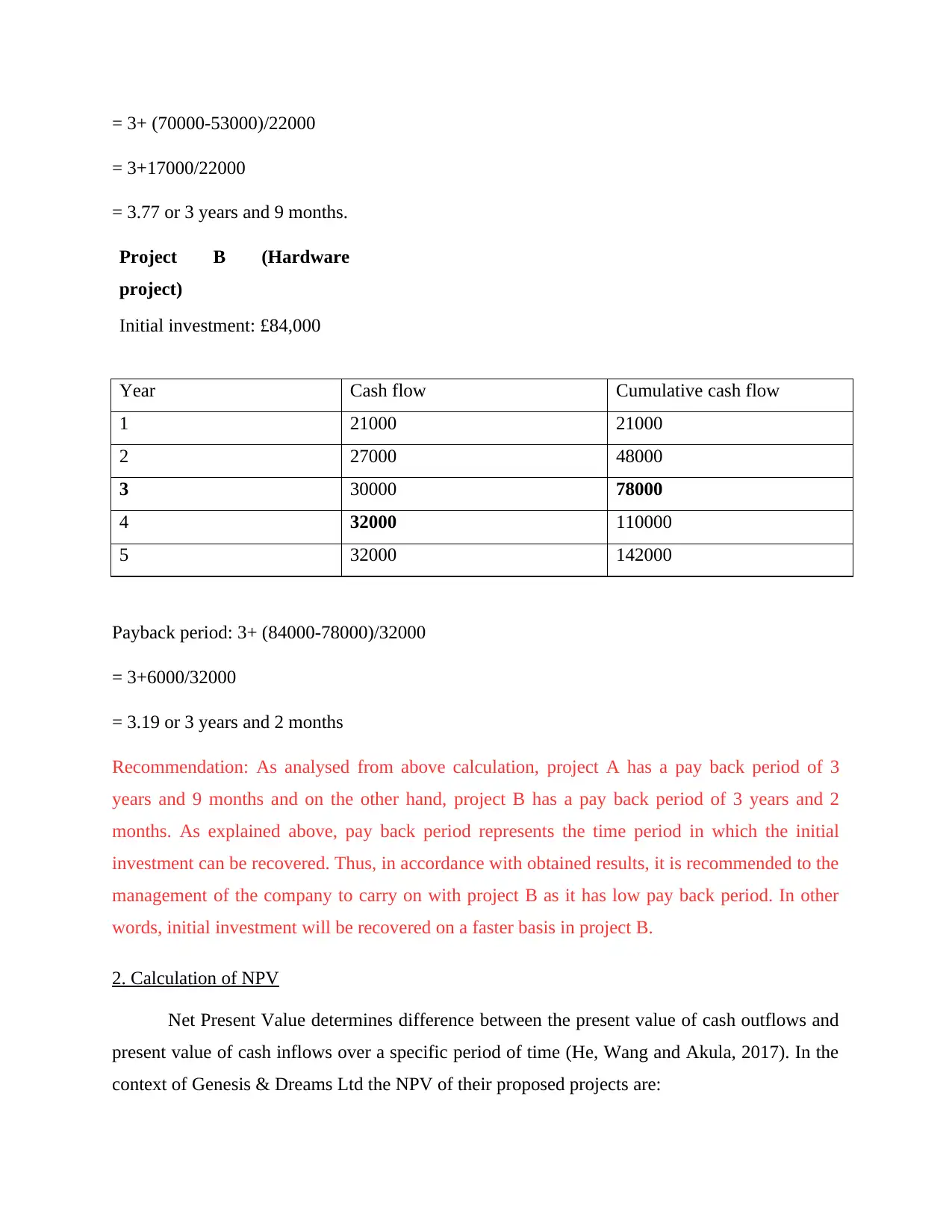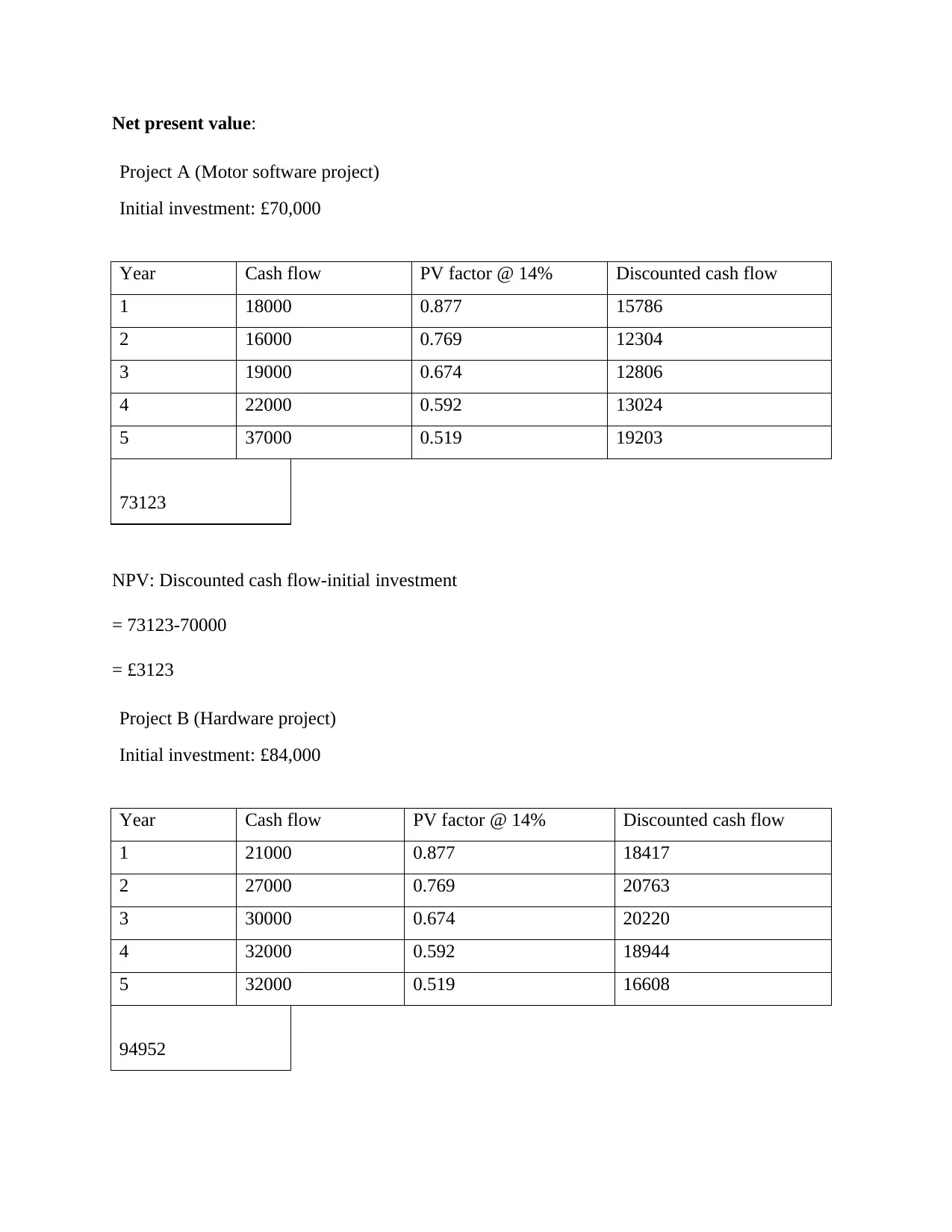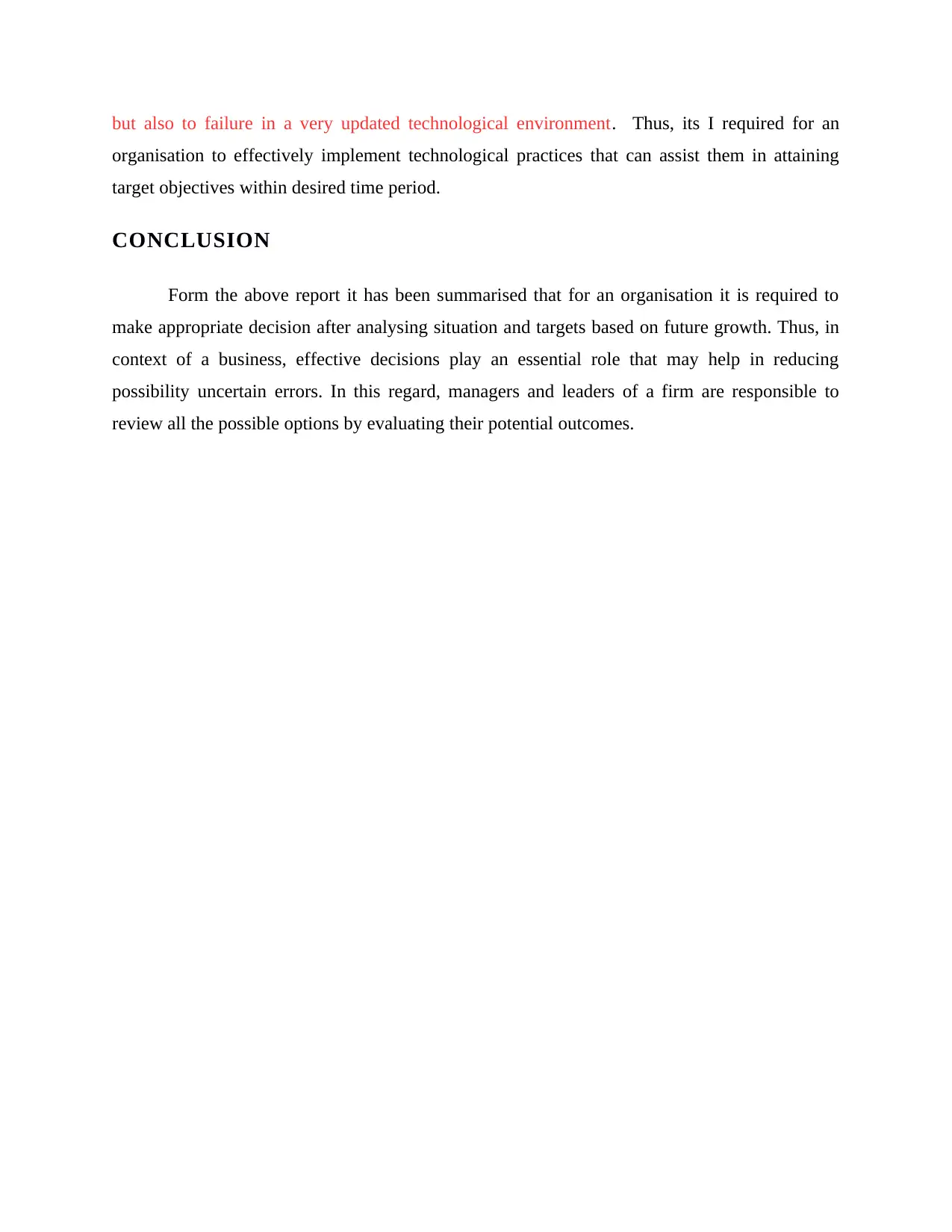Business Decision Making: Financial Analysis for Genesis & Dreams Ltd
VerifiedAdded on 2023/01/05
|9
|1693
|49
Report
AI Summary
This report provides a financial analysis for Genesis & Dreams Ltd, a UK-based construction company, to aid in its business decision-making process regarding potential investment projects. The report calculates the payback period and Net Present Value (NPV) for two proposed projects: a Motor software project and a Hardware project. The payback period analysis determines the time required to recover the initial investment, recommending Project B with a shorter payback period. The NPV analysis evaluates the profitability of each project, recommending Project B due to its higher NPV. The report also analyzes the benefits and drawbacks of both methods and discusses the importance of considering financial factors such as interest rates and profit, as well as non-financial factors like legal and technological aspects, in the decision-making process. The conclusion emphasizes the importance of informed decision-making for business growth and recommends careful evaluation of all options by management. The report aims to provide recommendations for Genesis & Dreams Ltd based on the financial analysis conducted.

Business Decision
Making
Making
Paraphrase This Document
Need a fresh take? Get an instant paraphrase of this document with our AI Paraphraser

TABLE OF CONTENTS
Introduction......................................................................................................................................3
Main body........................................................................................................................................3
1. Calculation of Pay Back Period ...............................................................................................3
2. Calculation of NPV..................................................................................................................4
3. Analysis....................................................................................................................................5
Conclusion.......................................................................................................................................7
REFERENCES................................................................................................................................8
Introduction......................................................................................................................................3
Main body........................................................................................................................................3
1. Calculation of Pay Back Period ...............................................................................................3
2. Calculation of NPV..................................................................................................................4
3. Analysis....................................................................................................................................5
Conclusion.......................................................................................................................................7
REFERENCES................................................................................................................................8

INTRODUCTION
The decision making process of business involves analysis of goals by gathering relevant
information by weighing the alternatives in order to make important decisions (Weygandt and
et.al., 2020). The importance of decision making for business is to reduce possibility of mistake
while accomplishing target goals of firm. This report is based on Genesis & Dreams Ltd which is
a construction company of UK. The management of firm wants to diversify their resources for
which they have been offered several business proposals. The objective of this report is to
provide recommendation to firm that which proposal is more beneficial to Genesis & Dreams
Ltd by evaluating pay back period and NPV.
MAIN BODY
1. Calculation of Pay Back Period
Payback period determines an amount of time that takes to recover the cost of
investment. It basically includes length of time an investment takes in order to reaches a break-
even point (Kimmel, Weygandt and Kieso, 2018). The analysis of two projects are:
Payback period:
Project A (Motor software
project)
Initial investment: £70,000
Year Cash flow Cumulative cash flow
1 18000 18000
2 16000 34000
3 19000 53000
4 22000 75000
5 37000 112000
Payback period: Year before recovery + amount to be recover/next years’ cash flow
The decision making process of business involves analysis of goals by gathering relevant
information by weighing the alternatives in order to make important decisions (Weygandt and
et.al., 2020). The importance of decision making for business is to reduce possibility of mistake
while accomplishing target goals of firm. This report is based on Genesis & Dreams Ltd which is
a construction company of UK. The management of firm wants to diversify their resources for
which they have been offered several business proposals. The objective of this report is to
provide recommendation to firm that which proposal is more beneficial to Genesis & Dreams
Ltd by evaluating pay back period and NPV.
MAIN BODY
1. Calculation of Pay Back Period
Payback period determines an amount of time that takes to recover the cost of
investment. It basically includes length of time an investment takes in order to reaches a break-
even point (Kimmel, Weygandt and Kieso, 2018). The analysis of two projects are:
Payback period:
Project A (Motor software
project)
Initial investment: £70,000
Year Cash flow Cumulative cash flow
1 18000 18000
2 16000 34000
3 19000 53000
4 22000 75000
5 37000 112000
Payback period: Year before recovery + amount to be recover/next years’ cash flow
⊘ This is a preview!⊘
Do you want full access?
Subscribe today to unlock all pages.

Trusted by 1+ million students worldwide

= 3+ (70000-53000)/22000
= 3+17000/22000
= 3.77 or 3 years and 9 months.
Project B (Hardware
project)
Initial investment: £84,000
Year Cash flow Cumulative cash flow
1 21000 21000
2 27000 48000
3 30000 78000
4 32000 110000
5 32000 142000
Payback period: 3+ (84000-78000)/32000
= 3+6000/32000
= 3.19 or 3 years and 2 months
Recommendation: As analysed from above calculation, project A has a pay back period of 3
years and 9 months and on the other hand, project B has a pay back period of 3 years and 2
months. As explained above, pay back period represents the time period in which the initial
investment can be recovered. Thus, in accordance with obtained results, it is recommended to the
management of the company to carry on with project B as it has low pay back period. In other
words, initial investment will be recovered on a faster basis in project B.
2. Calculation of NPV
Net Present Value determines difference between the present value of cash outflows and
present value of cash inflows over a specific period of time (He, Wang and Akula, 2017). In the
context of Genesis & Dreams Ltd the NPV of their proposed projects are:
= 3+17000/22000
= 3.77 or 3 years and 9 months.
Project B (Hardware
project)
Initial investment: £84,000
Year Cash flow Cumulative cash flow
1 21000 21000
2 27000 48000
3 30000 78000
4 32000 110000
5 32000 142000
Payback period: 3+ (84000-78000)/32000
= 3+6000/32000
= 3.19 or 3 years and 2 months
Recommendation: As analysed from above calculation, project A has a pay back period of 3
years and 9 months and on the other hand, project B has a pay back period of 3 years and 2
months. As explained above, pay back period represents the time period in which the initial
investment can be recovered. Thus, in accordance with obtained results, it is recommended to the
management of the company to carry on with project B as it has low pay back period. In other
words, initial investment will be recovered on a faster basis in project B.
2. Calculation of NPV
Net Present Value determines difference between the present value of cash outflows and
present value of cash inflows over a specific period of time (He, Wang and Akula, 2017). In the
context of Genesis & Dreams Ltd the NPV of their proposed projects are:
Paraphrase This Document
Need a fresh take? Get an instant paraphrase of this document with our AI Paraphraser

Net present value:
Project A (Motor software project)
Initial investment: £70,000
Year Cash flow PV factor @ 14% Discounted cash flow
1 18000 0.877 15786
2 16000 0.769 12304
3 19000 0.674 12806
4 22000 0.592 13024
5 37000 0.519 19203
73123
NPV: Discounted cash flow-initial investment
= 73123-70000
= £3123
Project B (Hardware project)
Initial investment: £84,000
Year Cash flow PV factor @ 14% Discounted cash flow
1 21000 0.877 18417
2 27000 0.769 20763
3 30000 0.674 20220
4 32000 0.592 18944
5 32000 0.519 16608
94952
Project A (Motor software project)
Initial investment: £70,000
Year Cash flow PV factor @ 14% Discounted cash flow
1 18000 0.877 15786
2 16000 0.769 12304
3 19000 0.674 12806
4 22000 0.592 13024
5 37000 0.519 19203
73123
NPV: Discounted cash flow-initial investment
= 73123-70000
= £3123
Project B (Hardware project)
Initial investment: £84,000
Year Cash flow PV factor @ 14% Discounted cash flow
1 21000 0.877 18417
2 27000 0.769 20763
3 30000 0.674 20220
4 32000 0.592 18944
5 32000 0.519 16608
94952

NPV: 94952-84000
= £10952
Recommendation: Net present value is an index of possible profitability of proposed projects and
it is a known fact, that higher the NPV, higher will the profitability index of proposed project. In
given case, project A and project B has net present vale of £3123 and £10952, respectively.
Therefore, it is recommended to the management that they should opt for project B due to the
reason that it has higher net present value.
3. Analysis
The benefits and drawbacks of the payback period and NPV
On the basis of above analysis, it has been summarised that Pay back period and NPV are
two most effective methods that may help an organisation to make effective decisions based on
their future targets. These methods can be appropriate for firm based on its requirements and
targets as:
Pay Back Period is a most effective method that may help Genesis & Dreams Ltd in
revealing the payback period of an investment (Kimmel, Weygandt and Kieso, 2018). Major
benefit of this approach is that it is simple to use and easy to understand. On the other hand,
major drawback of this approach for firm could be ignorance of value for time and money.
Furthermore, NPV is used to evaluate the time value of money that helps the
management to make better decisions. Major advantage of this method for firm that it provides
unambiguous measures to firm. On the other hand, major disadvantages of implementing this is
to initially select a discount rate and make decision according to this.
Financial/non-financial factors
For Genesis & Dreams Ltd, it is required to analyse financial and non-financial factors
that may have a direct impact over the operational and functional activities of firm. Thus, it is
needed for firm to segregate all the factors by analysing its effective need for firm as:
Interest rate is a financial factor which associate an amount that charged by lender for the
uses of their assets. Interest rates are basically determined in the form of percentage of the
= £10952
Recommendation: Net present value is an index of possible profitability of proposed projects and
it is a known fact, that higher the NPV, higher will the profitability index of proposed project. In
given case, project A and project B has net present vale of £3123 and £10952, respectively.
Therefore, it is recommended to the management that they should opt for project B due to the
reason that it has higher net present value.
3. Analysis
The benefits and drawbacks of the payback period and NPV
On the basis of above analysis, it has been summarised that Pay back period and NPV are
two most effective methods that may help an organisation to make effective decisions based on
their future targets. These methods can be appropriate for firm based on its requirements and
targets as:
Pay Back Period is a most effective method that may help Genesis & Dreams Ltd in
revealing the payback period of an investment (Kimmel, Weygandt and Kieso, 2018). Major
benefit of this approach is that it is simple to use and easy to understand. On the other hand,
major drawback of this approach for firm could be ignorance of value for time and money.
Furthermore, NPV is used to evaluate the time value of money that helps the
management to make better decisions. Major advantage of this method for firm that it provides
unambiguous measures to firm. On the other hand, major disadvantages of implementing this is
to initially select a discount rate and make decision according to this.
Financial/non-financial factors
For Genesis & Dreams Ltd, it is required to analyse financial and non-financial factors
that may have a direct impact over the operational and functional activities of firm. Thus, it is
needed for firm to segregate all the factors by analysing its effective need for firm as:
Interest rate is a financial factor which associate an amount that charged by lender for the
uses of their assets. Interest rates are basically determined in the form of percentage of the
⊘ This is a preview!⊘
Do you want full access?
Subscribe today to unlock all pages.

Trusted by 1+ million students worldwide

principal. The nature of such practices are based on a specific time period as while it noted on
annual basis, it determines as Annual Percentage Rate of a specific amount. If in given projects,
there is certain kind of interest involved than it will have to be taken in consideration in process
of calculating pay back period and also net present value. Interest amount is a cost that is
associated with the asset or project itself. Therefore, it becomes essential to take this amount in
consideration in process of evaluating feasibility of various alternatives of investment available.
Profit is also known as financial factor that recognize in the form of benefit or revenue
which earned by an organisation after conducting its business activities. Profit of a firm is
basically evaluated as the exceed amount over the cost, expenses and taxes. This is one essential
factor which help to pay all the returns and rewards to the employees. Sometimes profit is taken
as only yardstick of measuring the feasibility of a proposed project, this can lead to ignoring of
some other vital factors, such as, time period of profitability, cash flows, etc., therefore, it is
important to consider every element.
Non-Financial factors are those that has a direct impact over the business decision
making.
Legal factors determine rules and regulation which are determined by government of a
country. For an organisation it is required to implement all the regulation appropriately in order
to comply the legal practices in the firm. Main factors that contains tax liabilities, intellectual
property rights, import and export duty and so on. To consider this factor at the time of
evaluating the project feasibility is important as there may be a project which is successful in
every financial aspect but it is very difficult to comply with all legal formalities those are
applicable on the project. Thus, it is important to consider even non financial measures at the
time of evaluating alternatives of project.
Technological factors are most crucial aspects that impact directly upon business decision
making (Bennun and et.al., 2018). As nowadays, each and every organisation implements digital
practices in their business workings. Main reason behind this is to resolve issues of time and cost
because advancement of technology assist in providing appropriate solution to firm within a very
small duration. These kind of factors enhance quality of work as well as improves business
productivity. A business should consider this factor as well during the process of decision
making as if some out dated technology is used in the project, that surely it will lead to low cost
annual basis, it determines as Annual Percentage Rate of a specific amount. If in given projects,
there is certain kind of interest involved than it will have to be taken in consideration in process
of calculating pay back period and also net present value. Interest amount is a cost that is
associated with the asset or project itself. Therefore, it becomes essential to take this amount in
consideration in process of evaluating feasibility of various alternatives of investment available.
Profit is also known as financial factor that recognize in the form of benefit or revenue
which earned by an organisation after conducting its business activities. Profit of a firm is
basically evaluated as the exceed amount over the cost, expenses and taxes. This is one essential
factor which help to pay all the returns and rewards to the employees. Sometimes profit is taken
as only yardstick of measuring the feasibility of a proposed project, this can lead to ignoring of
some other vital factors, such as, time period of profitability, cash flows, etc., therefore, it is
important to consider every element.
Non-Financial factors are those that has a direct impact over the business decision
making.
Legal factors determine rules and regulation which are determined by government of a
country. For an organisation it is required to implement all the regulation appropriately in order
to comply the legal practices in the firm. Main factors that contains tax liabilities, intellectual
property rights, import and export duty and so on. To consider this factor at the time of
evaluating the project feasibility is important as there may be a project which is successful in
every financial aspect but it is very difficult to comply with all legal formalities those are
applicable on the project. Thus, it is important to consider even non financial measures at the
time of evaluating alternatives of project.
Technological factors are most crucial aspects that impact directly upon business decision
making (Bennun and et.al., 2018). As nowadays, each and every organisation implements digital
practices in their business workings. Main reason behind this is to resolve issues of time and cost
because advancement of technology assist in providing appropriate solution to firm within a very
small duration. These kind of factors enhance quality of work as well as improves business
productivity. A business should consider this factor as well during the process of decision
making as if some out dated technology is used in the project, that surely it will lead to low cost
Paraphrase This Document
Need a fresh take? Get an instant paraphrase of this document with our AI Paraphraser

but also to failure in a very updated technological environment. Thus, its I required for an
organisation to effectively implement technological practices that can assist them in attaining
target objectives within desired time period.
CONCLUSION
Form the above report it has been summarised that for an organisation it is required to
make appropriate decision after analysing situation and targets based on future growth. Thus, in
context of a business, effective decisions play an essential role that may help in reducing
possibility uncertain errors. In this regard, managers and leaders of a firm are responsible to
review all the possible options by evaluating their potential outcomes.
organisation to effectively implement technological practices that can assist them in attaining
target objectives within desired time period.
CONCLUSION
Form the above report it has been summarised that for an organisation it is required to
make appropriate decision after analysing situation and targets based on future growth. Thus, in
context of a business, effective decisions play an essential role that may help in reducing
possibility uncertain errors. In this regard, managers and leaders of a firm are responsible to
review all the possible options by evaluating their potential outcomes.

REFERENCES
Books & Journals
Weygandt, J.J. and et.al., 2020. Managerial Accounting: Tools for Business Decision-Making.
John Wiley & Sons.
Kimmel, P.D., Weygandt, J.J. and Kieso, D.E., 2018. Financial accounting: Tools for business
decision making. John Wiley & Sons.
He, W., Wang, F.K. and Akula, V., 2017. Managing extracted knowledge from big social media
data for business decision making. Journal of Knowledge Management.
Kimmel, P.D., Weygandt, J.J. and Kieso, D.E., 2018. Accounting: Tools for business decision
making. John Wiley & Sons.
Bennun, L. and et.al., 2018. The value of the IUCN Red List for business decision‐
making. Conservation Letters. 11(1). p.e12353.
Books & Journals
Weygandt, J.J. and et.al., 2020. Managerial Accounting: Tools for Business Decision-Making.
John Wiley & Sons.
Kimmel, P.D., Weygandt, J.J. and Kieso, D.E., 2018. Financial accounting: Tools for business
decision making. John Wiley & Sons.
He, W., Wang, F.K. and Akula, V., 2017. Managing extracted knowledge from big social media
data for business decision making. Journal of Knowledge Management.
Kimmel, P.D., Weygandt, J.J. and Kieso, D.E., 2018. Accounting: Tools for business decision
making. John Wiley & Sons.
Bennun, L. and et.al., 2018. The value of the IUCN Red List for business decision‐
making. Conservation Letters. 11(1). p.e12353.
⊘ This is a preview!⊘
Do you want full access?
Subscribe today to unlock all pages.

Trusted by 1+ million students worldwide
1 out of 9
Related Documents
Your All-in-One AI-Powered Toolkit for Academic Success.
+13062052269
info@desklib.com
Available 24*7 on WhatsApp / Email
![[object Object]](/_next/static/media/star-bottom.7253800d.svg)
Unlock your academic potential
Copyright © 2020–2025 A2Z Services. All Rights Reserved. Developed and managed by ZUCOL.





